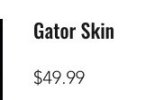Not much in the MSDS. It says the actual ingredients are "proprietary"
The chemicals are a silane mixture, which is primarily a water repellant and is used in coatings to increase adhesion of other ingredients in surface application. It would be one of the polymers in the mix. The nano-ceramic is not mentioned in the MSDS, but what the term means very small ceramic particles that are below 100nm in size. These are used in wear resistance coatings.
Whatever type of ceramic they use is what is bonded by the silanes. I would assume it is an RNC (resin nano ceramic).
Ceramic used to mean a very different thing than today. Ceramics are not just pottery. The spray ceramics on your car in the car wash. Those ceramics are primarily silicon dioxide compounds.
SAFETY DATA SHEET
Company Name: Baker Forge & Tool LLC Address: 110 Waterstone Dr., Boone, NC 28607 Email:
info@bakerforge.com
Last Issue Date: 2/27/2025 1.
COMPANY AND PRODUCT INFORMATION
Product Name: Gator Skin Product Number: GS-1001
Chemical Name:
Silane Mixture
Chemical Family:
Polymeric Resin-Solvent Blend Chemical
Formula:
Proprietary Blend
Product Use: FDA compliant, re-coatable, food safe, non-stick coating suitable for cutting instruments and blades
EPA Co. No.: 096235 EPA Reg. No.: 83019-1 EPA Est. No.: 96235-CA-1


